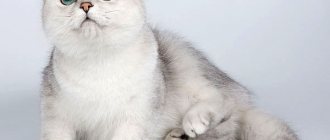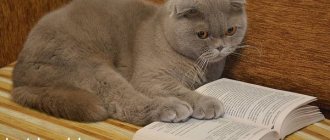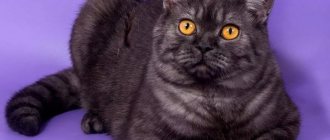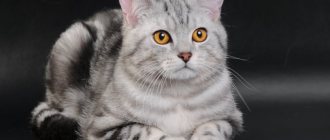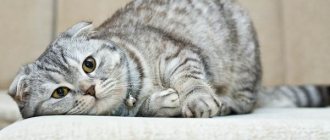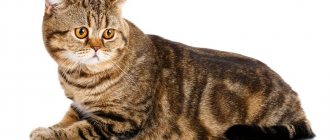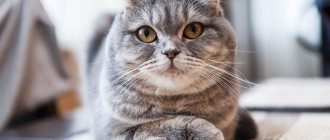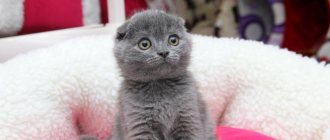Outwardly, this animal looks like a fluffy owl. The large round eyes and folded ears of a cat called Highland Ford are a distinctive feature of the breed. What representatives of Scottish Folds love, the secrets of breeding and maintaining the health of their pets: felinologists became interested in their furry charges even before the official recognition of the breed standard.
History of the breed
The Scottish Straight is the closest relative of the Scottish Fold, and their origin story is common. Cats with a characteristic kink in their ears appeared in England in the 60s of the last century. They were excellent mousetraps and therefore they began to be taken into homes for their benefit.
The breeding activity was started in Great Britain by an ordinary village resident, and then continued by experienced breeders. They were faced with the fact that kittens with straight ears sometimes appeared from lop-eared parents. For a long time this was considered a waste, and the popularity of their fold-eared counterparts was too great to think about breeding a straight-eared breed.
In an effort to fix the gene responsible for the unusual shape of the ear, it was noticed that there was a lot of harm from these experiments. This affected the health of cats, and they showed consequences - thickening of the bones and osteochondrodysplasia. To save the breed, they began to look for suitable animals that could help achieve the desired result without harming the health of the kittens.
A solution was found: for healthy offspring, a lop-eared female and a straight-eared male were required. Thanks to the intervention of previously rejected cats, the breed was able to continue its existence, and straight-eared cats received well-deserved respect and popularity.
In 2004, Scottish Straights were recognized as a separate breed.
Scottish Straight is a Scottish straight-eared cat. Scottish Fold is a Scottish fold cat.
Scottish fold cat color
Looking at the photo of the Scottish Fold, you can note that their color is quite unusual and attractive.
The most common Scottish Fold colors are:
Plain, that is, even, without spots or specks.
Two-tone, that is, symmetrical color.
Pointed, that is, the main shade is light, and the limbs and tail are dark.
Tortoiseshells, that is, spotted ones. This color is characteristic exclusively of females.
Smoky, that is, uniform ash-gray.
Tabby, that is, zonal color. Can have many colors and patterns.
Chinchilla is a color in which most of the hair is white and the smaller part is colored.
Ticked is a zoned color along the fibers.
Shaded, that is, the upper part of the fiber is colored and the lower part is white
Van - the body is white, and the muzzle and tail are colored.
Harlequins are white individuals with spots of different colors.
A funny and attractive pet will become a loyal friend for all family members.
Breed characteristics
The Scottish Straight cat is an affectionate, sociable and devoted animal. She is not very active and as she grows up, her interest in outdoor games remains behind. Possesses good health. Scottish Straights are very friendly and sociable animals. Average life expectancy is 12-15 years.
Coat and color
The Scottish Straight cat is the owner of a chic short fur coat. It feels like soft plush to the touch and you just want to touch it! The fur covers the body tightly.
Depending on the type of color of the animal, the texture of the coat also changes.
Scottish Straights are awarded by nature with a large number of colors, and each of them is recognized as a standard. The most common cats are:
- plain;
- tortoiseshells (tricolor);
- marble;
- tabby (hunting pattern of stripes, curved lines and dots);
- striped;
- bicolor;
- ticking.
Colors can also be different: black, white, brown, gray, harlequin, chinchilla, fawn, blue point, color point, mackerel and others.
Constitution
The appearance of the animal is misleading, as it is too similar to the British Shorthair cat. These breeds do not have much in common, except that both cats come from British lands.
Scottish Straights are distinguished by a rounded skull and a noticeably rounded area of the cheekbones and cheeks. The nose is almost without stop. The eyes stand out on the muzzle - large and perfectly round. Their gaze is open, attentive and as if asking the world about something. The ears are straight, with rounded, straight-looking tips. On the outside they are decorated with short hair, and on the inside with hair brushes that complement the exterior of the muzzle.
Males have more rounded cheeks and cheekbones than females.
What the eyes of an adult cat will look like is determined by the color. Thus, the blue color is characterized by yellow eyes, the golden or silver color is characterized by green eyes, and bicolors, solids, harlequins and vans have blue eyes.
The body of the Scottish Straight cat is long and clearly smaller than the body of the British cat, with whom they are often confused. The body can be called muscular, especially in the pelvis and paws. They are folded proportionally. The paws are powerful, rounded at the ends. The tail is long (it can reach the cat's forelimbs), mobile, round at the end.
Character
The Scottish Straight cat is considered to have an extremely calm and dispassionate character. Let's not deny this - representatives of the breed are indeed distinguished by restraint, although there are individuals who clearly show emotions. Scottish Straights are considered affectionate cats, and this is true - they will happily be near their owner, but still, if you decide to pick up the cat at the wrong time, the animal will definitely report it.
Representatives of the breed are calm and friendly. They get along well with other animals and do not mind being around dogs, provided that you teach the latter to live peacefully. Scottish Straights also treat small children well.
Scots are playful up to the age of one year, just like babies. After this, their interest in activities decreases and they prefer to spend their days contemplating the world and thinking.
You should not test the animal’s patience and create discomfort for it. The cat is proud and values personal space, so attempts to hold it in your arms or active calls to play may be regarded negatively. Animals tolerate loneliness well and do not require constant attention, but are happy to meet their owner after work and spend time with him.
Some say that these cats are highly trainable, while others deny this. It is known for sure that Scottish Straights are smart and can be trained to follow house rules. It is important to do this as soon as you have a kitten. Teach how to use a scratching post and litter box, and the results will not be long in coming!
Raising Scottish Folds
Acquired habits are very difficult to change. It's better to prevent them from appearing. From the very first day of being in the house, you need to make it clear to the baby what he can do and what pranks are not permissible. During educational activities, you need to take into account the animal’s biorhythm. It is better not to disturb the cat early in the morning, in the evening and after lunch.
Scottish dogs must follow a number of rules in the house:
- do not damage interior items;
- sleep, eat and go to the toilet in a designated area;
- do not touch house plants;
- get along peacefully with other animals in the house;
- don't steal food;
- keep clean;
- do not behave aggressively in response to affection.
The cat must follow prohibiting commands. This can be achieved through the use of rewards and punishments. But whether to teach her tricks or not is up to the owner to decide. The breed has one peculiarity - its representatives love to stand on their hind legs, and can remain in this position for quite a long time, especially if they are interested in something above. This is often used in cat training.
Maintenance and care
Scottish Straight cats do not require special care. They do not need daily walks on the street and even an infrequent outing “in public” will not arouse their interest. If you live in an apartment and want to have a pet, choose a Scottish Straight and you definitely won’t go wrong. With proper care, cats of this breed live 12-15 years.
To keep a Scottish cat, you will need a scratching post, a litter box, and bowls for food and water. I talked about how to make a scratching post at home in another article. There the manufacturing process is explained in detail and several scratching post options are given to choose from. Animals are very clean, so they will not go into a dirty tray, and if they smell the smell of missing food or stale water, they will refuse it. Therefore, the owner must ensure that the pet’s needs are met.
Scottish Straights do not need regular washing of their coat. There is no urgent need to bathe your pet every week or month. Most often this is done before shows or when the cat is really dirty. A separate article describes in detail how to bathe a cat yourself and without unnecessary nerves.
By the way, the Scottish Straight cat does not need houses at height. This breed avoids high places, so it is best to arrange a bed in the form of a regular cat house.
Nutrition
Good nutrition is the key to good health and longevity for your pet. Therefore, it is extremely important to ensure that your cat eats quality food. There are two ways to do this.
The first is to rely on yourself and feed the animal exclusively natural food that you yourself have chosen and prepared. In this case, the diet should be balanced and, if possible, adjusted by a cat nutritionist. The basis of the food should be lean meat - chicken, turkey, rabbit, beef. Supplements include cereals (oatmeal, rice, buckwheat), as well as some vegetables and herbs. A specialist will help you choose the amount of feed and the ratio of products.
The second option is to use special feed. When purchasing a kitten from a breeder, they will definitely tell you which food manufacturers to pay attention to. You should absolutely not buy cheap food - take care of your pet’s body. It is best to feed the animal with professional or semi-professional food. Yes, it is not cheap, but believe me, then you will spend more on visiting the veterinarian and medications for problems with internal organs.
It is strictly forbidden to feed an animal food from a human table, as well as:
- fatty meat and lard;
- starchy vegetables;
- fish and meat with bones;
- salted, smoked, spicy;
- baked goods, sweets;
- spicy food.
It is better to exclude dairy products, and give fermented milk infrequently. Fish can be given once a week and always sea fish. It should be remembered that a homemade diet does not provide important micro- and macroelements, whereas professional food already includes everything. Consult your veterinarian and he will prescribe a vitamin complex that is suitable for your pet if you choose home feeding.
Health
Scottish Straights have good good health. To maintain it, do not neglect regular visits to the veterinarian. Before the age of one year, you should follow the vaccination schedule and do not forget about this even when the kitten has grown up. The closer you get to old age, the more often you should visit a doctor. It is recommended to visit the veterinarian 2 times a year when the pet has crossed the 10 year mark.
Regardless of age, a cat should be treated for parasites. By the way, straight-eared Scots are less susceptible to genetic mutations and hereditary diseases, therefore they have enviable health and immunity.
Sometimes Scottish Straights suffer from problems with the stomach and genitourinary system, but this is due to improper maintenance, and not to the health characteristics of purebred cats. Therefore, by taking care of the quality of food and water, the cleanliness of bowls and the freshness of food, you make a huge contribution to the future of your pet.
Education
As a rule, the Scottish Fold cat reacts poorly to shouting at him. Due to several cases of unreasonable screaming by the owner, the cat can change for the rest of its life - it will be afraid of people, aggression will awaken in it.
The owner should not allow himself to act rudely. Many people, for example, like to carry cats by the scruff of the neck. But the Scots will not tolerate this. Firstly, they are quite heavy and feel pain if they are carried in this way. Secondly, it is very harmful to their spine. Scotch cats (as, indeed, all cats) need to be carried so that each of the paws has support in the air.
When raising and training Scots, the owner needs to be patient. A person must understand that this cat is not a shepherd dog or a poodle: she cannot remember many commands at one time simply physically. You need to gradually, slowly but surely learn commands with your cat one after another, from simple to complex - without haste or confusion.
Price
The price of a Scottish Straight cat kitten depends on its parents, rarity of color and class. Class is a kind of gradation of cats, depending on the exterior and the degree of compliance with the breed standard.
Pet class implies the presence of minor deviations that do not affect the health or character of the animal. Sometimes pet-class animals are given for mandatory castration so that the genes are not passed on to future generations. Animals of this class can be purchased for up to $200.
Breed-class cats are subject to breeding; they must have a veterinary passport and birth certificate. The price for a breed-class kitten is from 150 to 300 dollars.
Show class kittens have a stunning exterior and are often purchased for participation in exhibitions. The price of such a pet is at least $350 and above. Do not forget that if you want to purchase a purple animal, you will have to pay even more.
Reviews
I suggest learning more about Scottish Straight dogs from reviews of their owners. All comments are taken from the Otzovik website.
Man in animal form
The author of the first review says that her pet’s habits are very similar to those of humans, and in addition, sometimes the cat looks as if he understands all the problems of the owner. Separately, she notes the curiosity and activity of the animal. A cat behaves differently with strangers: it loves some and fears others.
Best cat breed
The second review is from the breeder, and this makes it very valuable. The author shares: the character of a cat depends on upbringing and the correct choice of animals for reproduction. Based on the experience of interacting with the breed, he concludes: there are many affectionate animals among Straights! They are easy to train, very smart, and get along well with other pets.
Affectionate purr
The author of the third review says that the Scottish Straight is unpretentious in care and maintenance. The cleanliness of the tray and his own hygiene are important to him. The cat is periodically combed, thanks to which the molting period passes smoothly. She is accustomed to trimming her nails and has become friends with the scratching post. The animal is very friendly by nature and behaves calmly with children.
I also suggest looking at an interesting review from the owner about Scottish cats, including Scottish Straights:
